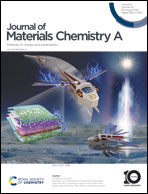Constructing a rhenium complex supported on g-C3N4 for efficient visible-light-driven photoreduction of CO2 to CO via a novel Z-scheme heterojunction†
Abstract
Visible-light-driven photocatalytic CO2 reduction is a promising approach to addressing the problem of global warming and the energy crisis. A Z-scheme photocatalyst comprising a Re(I) complex and a polymeric semiconductor (bulk graphitic carbon nitride (g-C3N4)) converted CO2 to CO even under the irradiation of low-intensity visible light. The electronic interaction between Re(I) and g-C3N4 units and the injection of electrons from g-C3N4 to the Re(I) complex improved the photocatalytic efficiency. The lower recombination of electron–hole pairs and the prolonged emission decay (the average emission lifetime τ = 5.8 ms) contributed to the increased overall efficiency of the hybrid system. The maximum turnover number (TON) of CO formation reached 28.56 after 240 min with a high CO selectivity (99.8%). Compared to the homogeneous photocatalyst Re(I), the TON of CO formation was increased by 5.6 times and CO selectivity was higher. Density Functional Theory (DFT) was employed to investigate the impact of the substrate-supported Re complex (Re(bpy-COOH)/g-C3N4) on the CO2 Reduction Reaction (CO2RR) activity. The results indicate that Re(bpy-COOH)/g-C3N4 presents a lower energy barrier for *CO2 to *COOH conversion, promoting *COOH formation more effectively than pure g-C3N4. Moreover, the energy barrier for *CO desorption is lower in Re(bpy-COOH)/g-C3N4 than in Re(bpy-COOH), suggesting a reduction in the strong binding of adsorbed CO intermediates, highlighting the intermediate ensemble effect at the active site. The improved CO2RR activity in Re(bpy-COOH)/g-C3N4 can be attributed to the balance between the enhancement of reaction activity and the binding energy of intermediates at the active site. The study of photocatalytic CO2 reduction (PCO2R) under low-intensity-visible-light irradiation and DFT investigation has reveal an insight into the CO2RR activity for CO2 reduction under various irradiation conditions.

- This article is part of the themed collections: Celebrating International Women’s day 2024: Women in Materials Science and #MyFirstJMCA


 Please wait while we load your content...
Please wait while we load your content...